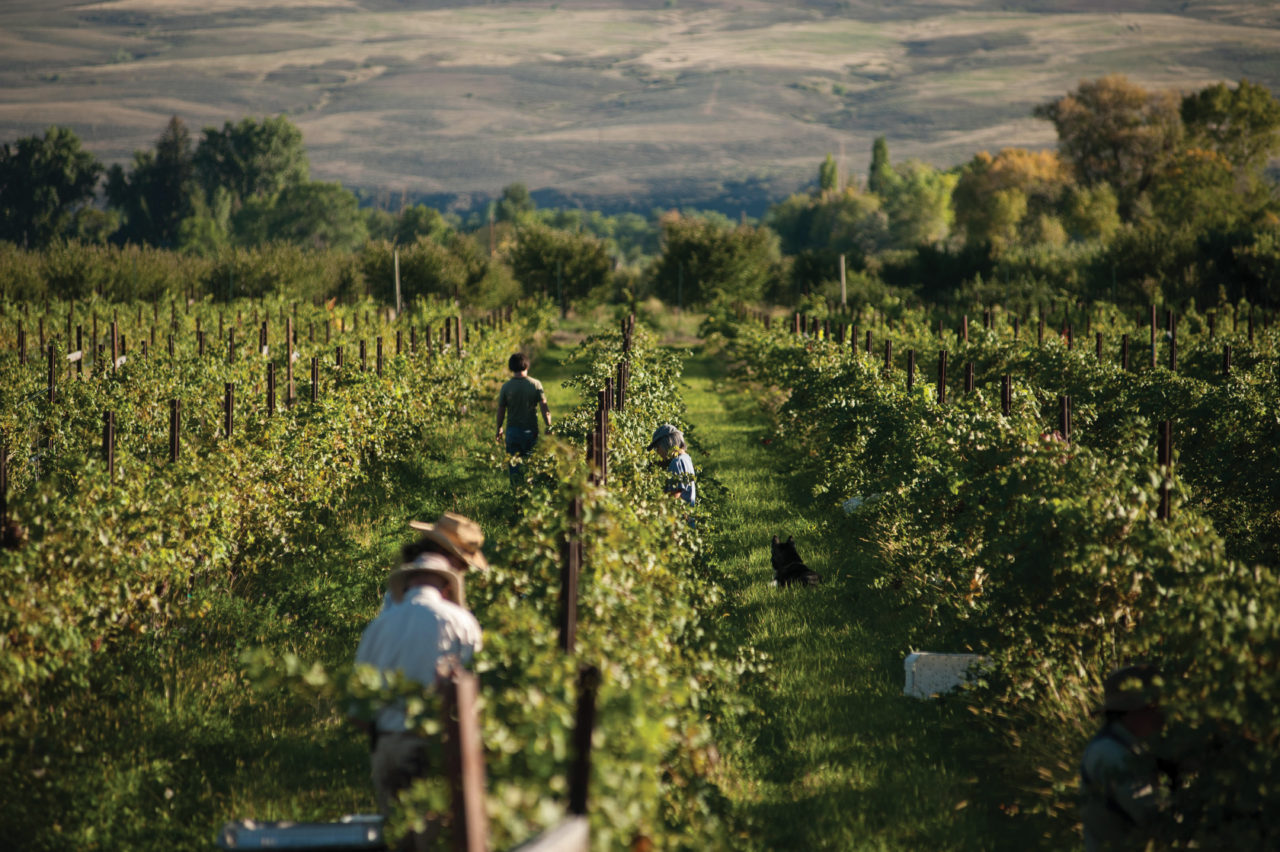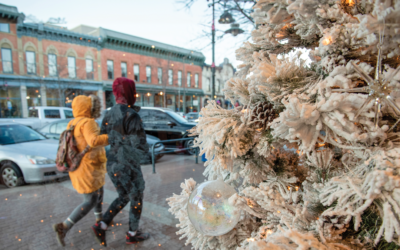Beer isn’t the only beverage made in the Centennial State.
The region’s high elevations and loamy soil create the perfect conditions for growing grapes. It’s time to give Colorado wine a shot.
It’s no secret: Beer is a favorite Colorado beverage for residents and visitors alike. But there’s another industry fermenting right under our noses. Colorado is chockful of wineries growing in both size and scale. From corner to corner, the state boasts 140 commercial wineries, producing 178,000 cases in 2017. Varietals range widely from Rieslings to Pinot Noirs.
If you haven’t tried Colorado wine in a while, it’s time to revisit.

A wine dinner at Stone Cottage in Paonia.
Why So Unique?
Soil, climate, and elevation all contribute to the finished product sipped from our glasses. And there’s nothing quite like Colorado’s natural conditions. Colorado soil is similar to Burgundy in France—clay loam with limestone gravel and a caliche base—all the right elements for terrific vines, says Wink Davis from Mesa Winds Winery in Hotchkiss. Yet, this type of soil combined with our Colorado climate provides, “a different spectrum of flavors,” he says. The North Fork Valley is ideal for growing: not too hot and with nice cool nights.
In the Four Corners area, vintner Guy Drew uses the diversity of the high desert climate to his advantage. He produces many grape varietals. Cabernet Sauvignon grows in one vineyard and Rieslings in another, yet both manage to thrive mere miles apart. He states that success depends on matching the grapes to the location. Also, irrigation is plentiful in the Montezuma Valley, which is a bonus.
And because of Colorado’s four distinct seasons, there are very few pests. The soil freezes, killing any nuisances before the next crop. Growers in other states, such as California, need to use additional pesticides to keep their vines healthy.

Photo courtesy of Jacob Helleckson
All these combined factors impact the grapes. Since Colorado vineyards are planted at the highest altitudes, sunlight gives grapes the right balance of sweetness and acidity without winemaker’s fiddling. This, “allows grapes to express the unique character of place in the wines we produce,” says Davis. Nowhere in the world can you replicate Colorado wine.
And why try? Paonia’s Stone Cottage Cellars produces award-winning wines. Owner Karen Helleckson describes her Pinot Noirs as incredibly fruity, but not sweet. They have crisp acidity and are crazy flavorful. She also credits the soil and high elevation for this intense fruit flavor.
Although most vineyards produce recognizable varietals like Merlot, Cabernet Franc and Chardonnay, cold-hardy boutique grapes thrive here. And what they can’t grow, vintners buy from Washington, Oregon and California. This is typical practice and provides winemakers greater options.
Vintner Bill Conkling at Ten Bears Winery in Laporte (the state’s northernmost vineyard) grows complex red grapes called Marquette. They’re a hybrid from Minnesota that result in nice reds bottled in 100 percent single-varietal or used in a blend. He also produces La Crescent, a short-growing, amazing white. Since wine requires thousands of pounds of grapes, Conkling sources quantities from out west to shore-up his small acreage.
At Mesa Winds, Davis loves the Meunier. It’s another short season grape that buds late and ripens early—perfect for the Colorado climate. Closely related to Pinot Noir, Meunier is fragrant and provides a subtle fruitiness. Davis also grows Chambourcin, which has a dark red color and a big personality. These grapes are ideal for blending, making wine production a real art. What he can’t grow on his own vines, Davis buys from neighboring West Elks vineyards. But in the end, it’s all Colorado fruit inside the bottle.

Stone Cottage grapes. Photo courtesy of Steve Huntley.
Wine = Work
Many wine drinkers don’t appreciate the hard work and discipline needed to grow grapes. Each step takes time, especially when it comes to harvesting. Never an exact science, Helleckson says the grapes are “ready when they’re ready.”
Drew explains it takes five years to have a full crop of mature and predictable grapes. Year one is all about establishing roots, since fruit will only grow on old wood. In the second year, vines have more roots and provide new growth. Only 25 percent of a total crop is expected by year three. It’s a slow process that takes patience. And growing wine grapes is never a sure bet, especially when Mother Nature is involved.
And then there’s the wine making itself–a learned practice. “Everyone starts off as a hobbyist,” says Conklin. With more education, winemakers get better at their craft. They improve or at least, “make less mistakes since last year’s vintage,” he laughs.
Winemaking is not only an art, but a business and there’s always a bottom line. Vintners need to continually elevate their hand-crafted products or they’re out of a job.
Looking to the Future
In the past, Colorado wine was known for overt sweetness and simplicity. Not anymore.
Trends in Colorado wine production and consumption are on par with national statistics–around 15 percent annual growth over the past two decades. Numbers don’t lie. Coloradans like Colorado wine.
Helleckson says state wine organizations have taken the time to educate growers on technique development, so products are increasing in both quality and quantity. Grapes are maturing. Nuances are starting to flourish. Winemakers are excelling at their craft.
Colorado wineries have been and will continue to be small producers. Ahhh, the laws of supply and demand…since quantity will always be an issue, prices will never drop too much lower. However, most bottles range in the $20-$25 price point, which is reasonable for small-batch production. And a bargain once tasted.
How to Get It
And now the bad news: Most Colorado wines aren’t distributed at local liquor stores. The limited production sizes and associated costs aren’t economical. Most wineries will ship, but the expense can equate to another bottle of wine.

Sampling white wines at Stone Cottage.
The good news: Road trip!
The best part of buying Colorado wine is the adventure. Wineries and vineyards are tucked in exceptionally beautiful locations—day-trippers can see Anasazi ruins, buy Palisade fruit, and experience gorgeous mountain vistas. So, gas up, collect lots of memories and stockpile a few cases.
It’s worthwhile to organize and visit several wineries on one trip. Tasting rooms provide an opportunity to talk with the owner and winemaker, says Drew, leading to “a better experience for everyone.” At a tasting room, sample and experiment with new varieties and blends. Find a new favorite. More importantly, you’re guaranteed to like what you buy. Plus, vintners usually offer a 10 percent discount for a case (12 bottles).
To plan a trip, check out www.coloradowine.com for a helpful interactive map. Just don’t forget to make room in the Subaru.
The Colorado Wine Industry Board recently named 13 wines for its 2018 Governor’s Cup Collection—previously known as the Governor’s Cup Case. This year’s competition included 344 wines from 49 local wineries—the most submissions in the competition’s nine-year history. A panel of sommeliers, chefs, writers and wine experts from around the country selected the winners. The Best of Show winner will be officially announced during the annual Colorado UnCorked Tasting Event on November 8 at The History Colorado Center. This event will be the first and only opportunity for the public to try all of the award-winning wines at the same time.
Colorado, Uncorked
2018 Colorado Governor’s Cup Collection
Bookcliff Vineyards (Boulder)—2015 Cabernet Franc Reserve, Colorado
Bookcliff Vineyards (Boulder)—2016 Tempranillo, Colorado
Carlson Vineyards (Palisade)—Plum Wine, 100% Grand Valley plums
Carlson Vineyards (Palisade)—2017 Sweet Gewürztraminer, Grand Valley AVA
Colorado Cellars (Palisade)—1999 Port, Colorado
Colterris (Palisade)—2017 “CORAL” White Cabernet Sauvignon, Grand Valley AVA
Colterris (Palisade)—2016 “Estate Selection, Riverside Vineyard” Merlot, Grand Valley AVA
Colterris (Palisade)—2016 Petit Verdot, Grand Valley AVA
The Infinite Monkey Theorem (Denver)—2016 Cabernet Franc, Grand Valley AVA
Monkshood Cellars (Minturn)—2016 Syrah, Grand Valley AVA
Red Fox Cellars (Palisade)—2016 Teroldego, Grand Valley AVA
Snowy Peaks Winery (Estes Park)—2016 Elevé (Rhône-style red blend), Grand Valley AVA
Whitewater Hill Vineyards (Grand Junction)—2017 Riesling, Grand Valley AVA
The Colorado Wine Industry Development Board (CWIDB) is part of the Colorado Department of Agriculture dedicated to promoting and furthering the development of Colorado’s grape growers and vintners. The CWIDB supports the efforts of more than 140 wineries throughout the state, producing an increasing array of premium-quality wines. For additional information, visit www.coloradowine.com.
Cover Photo Credit: MesaWinds Vinyard






